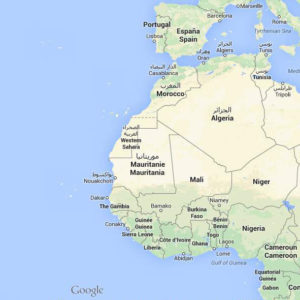 Centre-South, Morocco
Centre-South, MoroccoFind, 2000
Iron meteorite, II AB
Complete specimen 48 000g
Size: 4,3 x 3,6 x 2,8 cm
History:
(H. Chennaoui Aoudjehane, M. Aboulahris, FSAC) Two small pieces of iron were collected in 2000 in the Agoudal area, High Atlas Mountains, Morocco, and sold to tourists. In September 2011, one piece was sold to a dealer in Errich, who recognized it as an iron meteorite. During the last months of 2012, systematic searching by meteorite hunters with metal detectors resulted in the discovery of a large number of meteorites, mostly small. Many pieces were collected on the surface or buried a few cm deep. The largest piece recovered was 60 kg, buried ~50 cm below the surface. On 9 February 2013, H. Chennaoui Aoudjehane, M. Aoudjehane and M. Aboulahris collected 200 g of specimens; the listed coordinates are those of the largest piece they recovered. The strewnfield is not yet clearly defined.
Finding of the meteorite pieces have started the discussion about the origin of the two lakes on the area called Isli and Tislit. Nowadays are thought to be impact craters and meteorites are thought to relate that impact. The impact craters of Isli and Tislit, 32˚13’N, 05˚33’W; 32˚12’N, 05˚38’W are respectively, located at 10 km and 4 km from the Imilchil village on the Central High Atlas in Morocco at respective altitudes of 2272 meters and 2266 meters. They are spaced apart from each other by 9.4 km. The origin and the date of formation of these two lakes are still unknown today. Surveys undertaken near them and in the surrounding areas lead to believe that they correspond to a dual meteoritical impact crater.
based on these observations, the circular structures of Isli and Tislit discovered in the north of Imilchil (Morocco) were produced by the impact of a small asteroid with more than 100 meters in diameter. The dual impact crater, oriented east-west, resulted from the fragmentation of a meteorite at its input in the Earth’s atmosphere in two pieces which then produced two craters, oriented along the trajectory of the fireball. This phenomenon has been observed in three double craters identified in the world. According to the state of conservation of the meteorite into the sedimentary layers “Soltanian” and the dating of ancient lake sediments of the Isli lake , we can estimate their age limit to 40,000 years.
Physical characteristics:
Total mass is >100 kg. Hundreds of small pieces (1-100 g), many 100-1000 g, and a few pieces >1 kg, have been recovered. The majority of collected material occurs as 2-5 cm, irregularly shaped shrapnel pieces. Most pieces have a thin weathering rind. Some smaller bullet-shaped (~cm-sized) fragments are rounded, showing well-developed fusion crust.
Petrography:
(L. Garvie, ASU) Decimeter-sized pieces show a coarse pattern of irregular, interlocking kamacite grains; some grains with sub-boundaries. Widmanstätten pattern not evident in the small sections studied. Grain boundaries commonly curved. Etched pieces range from shiny with well-developed Neumann bands, to pieces with a matte appearance, typical of the hatched ε-structure. The shock-hatched regions show incipient recrystallization, with secondary growth of irregularly-shaped (to 1 mm) kamacite. No plessite observed. Schreibersite abundant occurring as cm-sized skeletal crystals at the centers of kamacite crystals, as rhabdites, and as a grain boundary precipitate. Rhabdites locally numerous as sharp, 10-25 μm faceted prisms. Scattered troilite nodules, to 1 cm. Troilite not surrounded by schreibersite, but instead large skeletal schreibersite is situated a few mm away. Heat-affected zone visible on some stones. Several of the smaller pieces, and especially the rounded bullet-shaped stones, have fusion crust and heated-affected zone of varying thickness; some completely recrystallized.
Geochemistry:
(C. Herd and G. Chen, UAb): ICP-MS data, Ni 5.5 wt%, Co 4.1 mg/g, Ga 58 μg/g, Ir < 0.04 μg/g and Au ~ 1 μg/g.
Classification:
Iron, IIAB. Structurally similar to Ainsworth.
Specimens:
Type specimens include 2406 g, ASU; 17.5 g, UAb; 200 g, FSAC
Specimen Description:
A complete piece with nice desert patina.
Comments:
Agouldal presents a rare crater forming iron meteorite.
References:
Meteoritical Bulletin Database
International Journal of Astronomy and Astrophysics
Vol.3 No.2A(2013), Article ID:32992,4 pages DOI:10.4236/ijaa.2013.32A001
Jarkko Kettunen Meteorite Collection © 2024
